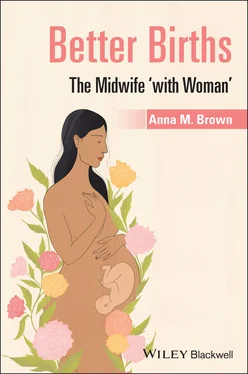Two reviewers carried out the literature search and almost identical publications were listed in the final search. Titles containing the ‘with woman’, one‐to‐one care/carer, continuity of care/carer, doula and birth companion were combined with search terms of midwives, midwifery practice/care. Abstracts were also screened for these words or terms. The resulting studies were then scanned for attributes of behaviour, process or environment pertaining to the concept of being ‘with woman’. A second screening sought words or terms that expressed or described the consequence or result of the ‘with woman’ concept. Search results which contained none of the above criteria were excluded.
Both reviewers assessed the final papers selected and entered details of year of publication, reason for selection – i.e. ‘with woman’ term or associated terms in the title, abstract, or text content – on a simple data extraction sheet. The resulting literature was further analysed using the antecedents of emotional, psychological, spiritual and physical health, midwifery skills and knowledge and organisational working patterns, resulting in attributes pertaining to the behaviour, process and environment of the ‘with woman’ concepts and the resulting subsequent consequences as per Table 1.3below.
Characteristics of the ‘with Woman’ Concept
Limited literature exists on the ‘with woman’ concept and mostly presents a professional point of view and the implications for midwives in attempting to fulfil the concept. Much of the research implies that the midwife ‘with woman’ has physical, mental and resource implications (Leap 2009; Hunter 2009; Leinweber and Rowe 2010; Aune et al. 2014; Hunter 2015; Astrup 2016; Power et al. 2016; Reed et al. 2016; Knapp 2017a; Hunter et al. 2017; Amir and Reid 2018; Bradfield et al. 2019b, c; Brady et al. 2019).
A dearth of literature on this topic, from women's perspectives, exists; particularly in publications outside the UK (Dahlberg and Aune 2013; Bradfield et al. 2018a). The evidence suggests that although some women document the various benefits for childbearing women when the midwife is ‘with them’ in various situations and aspects, many express differing views of the ‘continuity of care’ and carer concept (Huber and Sandal 2009; Nystedt et al. 2014; Perriman et al. 2018). Their childbirth outcomes are also affected in terms of morbidity, such as birth trauma – both physical and psychological – and neonatal outcomes (Yoshida and Sandall 2013; McDonald 2011).
Table 1.3 Antecedents, attributes and consequences of the ‘with woman’ concept resulting from Rodgers' Evolutionary Concept Analysis framework.
| ‘With woman’ antecedents |
Attributes (behaviour) |
Consequences |
| Emotional wellbeing Hunter (2009) Huber and Sandall (2009) Aune et al. (2014) Hunter (2015) |
Positive presence and calm Listening Acknowledging feelings Empathy Reassurance Affirmation Sensitivity |
Relational continuity MW compassion MW understanding Mutual recognition Therapeutic space Respect for woman Empowerment |
| Psychological health Bradfield et al. (2019c) Perriman et al. (2018) Nystedt et al. (2014) |
Trusting relationship Woman‐centred care Known midwife Continuity of midwifery care Co‐participation Nurturance Helpfulness |
Impact on MW and woman Greater satisfaction Personalised care Psychological and physical support Decreased anxiety/fear Courage to give birth |
| Spiritual health Hunter et al. (2017) Dahlberg and Aune (2013) |
Giving of self Engagement/connectedness Mindfulness Intuitive Awareness/recognition |
Empowered woman Provides confidence Positive birth experience Holistic care provision Acknowledging expectations |
| ‘With woman’ antecedents |
Attributes (process) |
Consequences |
| Midwifery knowledge Bradfield et al. (2018a,b) Brady et al. (2019) Leap (2009) |
Dynamic developing construct Control and empowerment Woman‐centred care Midwifery guidance |
Partnership Empowers women Supports/hinders behaviours Safe, supportive and gentle |
| Midwifery skills Power et al. (2016) Bradfield et al. (2019b) Astrup (2016) |
Responsibility to the woman Advocacy Communication Professional expertise, identity Midwifery responsibility and flexibility |
Teaches competence and confidence Better birth experience Greater maternal satisfaction |
| ‘With woman’ antecedents |
Attributes (environmental) |
Consequences |
| Physical wellbeing McDonald (2011) Reed et al. (2016) |
Continuous support Birth aids/equipment Sustaining strength Comfort Touch or closeness/support Companion/doula One‐to‐one care/carer Ritual companion |
Reduced pain, less analgesia Shorter labour, fewer operative outcomes Maternal satisfaction Personal attention Continuous labour support Being there Better birth experience |
| Resources: organisational factors and costs Leinweber and Rowe (2010) Yoshida and Sandall (2013) Knapp (2017a,b) Amir and Reid (2018) |
Staff shortages/lack of time Reduced maternity services Cost to midwives Burnout |
Serious incidences Morbidity/mortality Midwifery burnout Midwifery dissatisfaction |
As identified from the literature above, the ‘with woman’ concept is a complex phenomenon and includes a range of antecedents. These consider emotional, psychological and spiritual wellbeing, physical health, midwifery knowledge and skills and resource implication to fulfil the concept. Each of these antecedents will be considered in turn and the attributes pertaining to behaviour, process and environment are examined for the subsequent consequences.
Wellbeing and Health Through Positive Behaviour
The terms ‘emotional wellbeing’ and ‘psychological and spiritual health’ were identified from the literature as antecedents to the ‘with woman’ concept (Hunter 2009; Huber and Sandall 2009; Aune et al. 2014; Hunter 2015 for emotional wellbeing and Bradfield et al. 2019c; Perriman et al. 2018; Nystedt et al. 2014 for psychological and spiritual health). The study by Hunter (2009) suggests that a Positive Presence Index (PPI) administered to women during labour and birth, either in a hospital or a birth centre environment, resulted in a higher PPI scores for those women in the birth centre due to improved interaction and personal quality of midwifery care. A meaningful relationship based on trust through continuity of midwifery care (Perriman et al. 2018) and a shared philosophy between a woman and midwife has an impact of satisfaction on both (Bradfield et al. 2019c) and is a consequence of this approach. Support during childbirth results in reduced anxiety and fear, and courage of the woman to give birth (Nystedt et al. 2014).
A calm and positive midwifery presence as described by Huber and Sandall (2009), and provision of continuous support through relational competence Aune et al. (2014), are other attributes of the ‘with woman’ concept. The midwife demonstrates behaviour of listening, acknowledging the woman's feelings, displays empathy and sensitivity and provides reassurance and affirmation of the woman's ability to birth her baby. Hunter (2015) suggests that a therapeutic space is created through mutual recognition and respect as attributes, which consequently empower both the woman and the midwife (Dahlberg and Aune 2013; Andrews 2017). Hunter et al. (2017) found that the attribute of mindfulness can provide a way for midwives to contain levels of stress. This can be achieved through a reconnection with self and the woman to improve job satisfaction and provide holistic ‘with woman’ care.
Читать дальше












